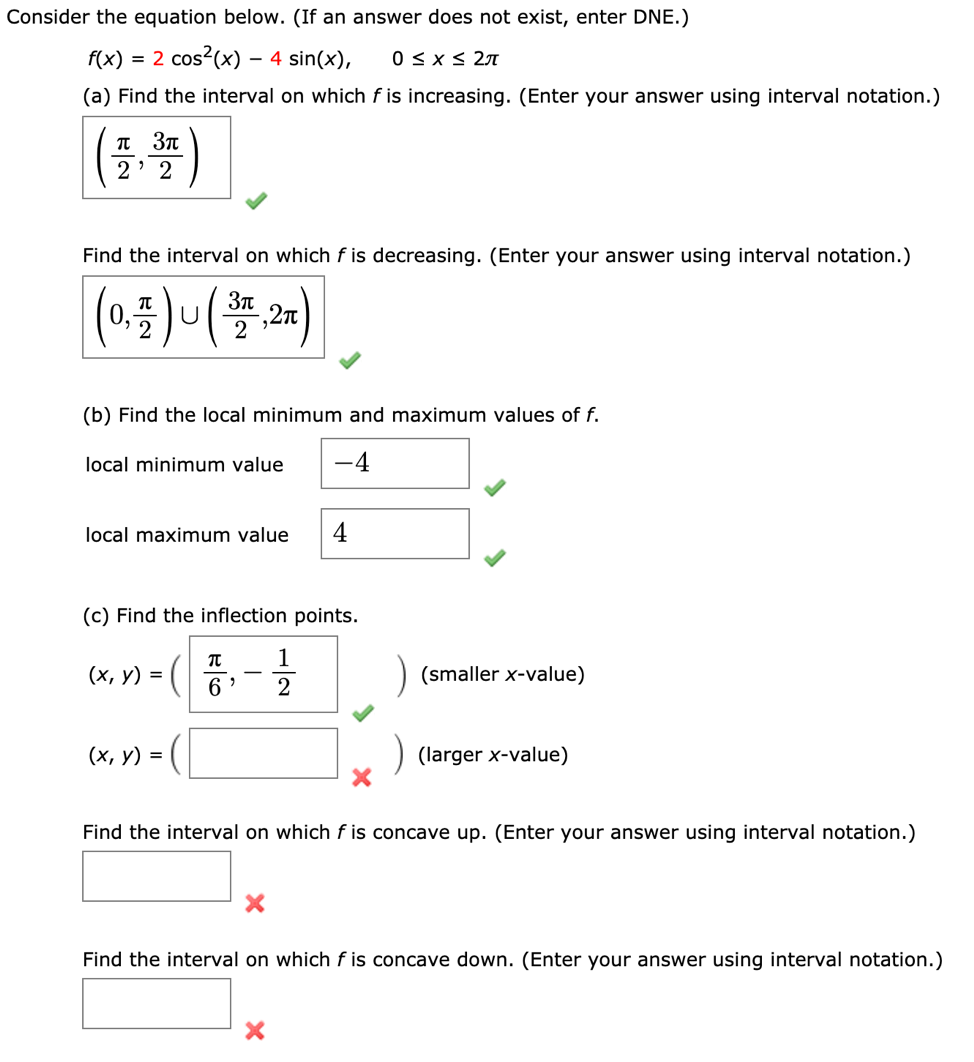Consider the equation below. (If an answer does not exist, enter DNE.) f(x) = 2 cos?(x) – 4 sin(x), 0 < x < 27 (a) Find the interval on which f is increasing. (Enter your answer using interval notation.) (3*) Find the interval on which f is decreasing. (Enter your answer using interval notation.) |(0)u(*) Зл (b) Find the local minimum and maximum values of f. local minimum value -4 local maximum value 4 (c) Find the inflection points. (х, у) %3 (smaller x-value) (х, у) %3D ) (larger x-value) Find the interval on which f is concave up. (Enter your answer using interval notation.) Find the interval on which f is concave down. (Enter your answer using interval notation.)
Consider the equation below. (If an answer does not exist, enter DNE.) f(x) = 2 cos?(x) – 4 sin(x), 0 < x < 27 (a) Find the interval on which f is increasing. (Enter your answer using interval notation.) (3*) Find the interval on which f is decreasing. (Enter your answer using interval notation.) |(0)u(*) Зл (b) Find the local minimum and maximum values of f. local minimum value -4 local maximum value 4 (c) Find the inflection points. (х, у) %3 (smaller x-value) (х, у) %3D ) (larger x-value) Find the interval on which f is concave up. (Enter your answer using interval notation.) Find the interval on which f is concave down. (Enter your answer using interval notation.)
Calculus: Early Transcendentals
8th Edition
ISBN:9781285741550
Author:James Stewart
Publisher:James Stewart
Chapter1: Functions And Models
Section: Chapter Questions
Problem 1RCC: (a) What is a function? What are its domain and range? (b) What is the graph of a function? (c) How...
Related questions
Question

Transcribed Image Text:Consider the equation below. (If an answer does not exist, enter DNE.)
f(x) = 2 cos?(x) – 4 sin(x),
0 < x < 27
(a) Find the interval on which f is increasing. (Enter your answer using interval notation.)
(3*)
Find the interval on which f is decreasing. (Enter your answer using interval notation.)
|(0)u(*)
Зл
(b) Find the local minimum and maximum values of f.
local minimum value
-4
local maximum value
4
(c) Find the inflection points.
(х, у) %3
(smaller x-value)
(х, у) %3D
) (larger x-value)
Find the interval on which f is concave up. (Enter your answer using interval notation.)
Find the interval on which f is concave down. (Enter your answer using interval notation.)
Expert Solution
This question has been solved!
Explore an expertly crafted, step-by-step solution for a thorough understanding of key concepts.
This is a popular solution!
Trending now
This is a popular solution!
Step by step
Solved in 8 steps with 9 images

Recommended textbooks for you

Calculus: Early Transcendentals
Calculus
ISBN:
9781285741550
Author:
James Stewart
Publisher:
Cengage Learning

Thomas' Calculus (14th Edition)
Calculus
ISBN:
9780134438986
Author:
Joel R. Hass, Christopher E. Heil, Maurice D. Weir
Publisher:
PEARSON

Calculus: Early Transcendentals (3rd Edition)
Calculus
ISBN:
9780134763644
Author:
William L. Briggs, Lyle Cochran, Bernard Gillett, Eric Schulz
Publisher:
PEARSON

Calculus: Early Transcendentals
Calculus
ISBN:
9781285741550
Author:
James Stewart
Publisher:
Cengage Learning

Thomas' Calculus (14th Edition)
Calculus
ISBN:
9780134438986
Author:
Joel R. Hass, Christopher E. Heil, Maurice D. Weir
Publisher:
PEARSON

Calculus: Early Transcendentals (3rd Edition)
Calculus
ISBN:
9780134763644
Author:
William L. Briggs, Lyle Cochran, Bernard Gillett, Eric Schulz
Publisher:
PEARSON

Calculus: Early Transcendentals
Calculus
ISBN:
9781319050740
Author:
Jon Rogawski, Colin Adams, Robert Franzosa
Publisher:
W. H. Freeman


Calculus: Early Transcendental Functions
Calculus
ISBN:
9781337552516
Author:
Ron Larson, Bruce H. Edwards
Publisher:
Cengage Learning